Why are SNM’s Coast to Coast training trips so popular?
– people like what we do
Why are they so successful with high rates of passing and grade 2 certificate completion?
– our courses are well planned and well executed
Why won’t you publish your Coast to Coast Kayak Tips that you teach on your courses?
– ok, fine, here you go…
1. Shallow Water Drag (Frictional Resistance): Shallow water increases drag due to friction between the hull and the riverbed, significantly slowing down your boat. The technical term here is frictional resistance, which is higher in shallows. This should be relevant for obvious reasons; stay out of the shallows, go deeper; go faster.
2. Path of Least Resistance: Always aim for the path of least resistance in rapids and ripples. Visualize smooth, consistent lines, avoiding eddies and turbulent areas. In low water, pick channels with continuous deeper water. A reference point is if the peaks and troughs are choppy enough to go over your bow, stay out of it. The bouncing around will upset your technique and mental game (slowing you down), the rocking of the boat creates friction when the bow dives and the stern submerges (slowing you down)…regardless of boats slicing through the peaks and troughs, this still slows you down. The laminar flow is sill abundant for you to catch on the sides.
3. Corner Cuts > 90 Degrees: On sharper bends (>90-degree cut), position yourself early to follow the apex of the turn. The inside line usually offers a quicker transition. In kayaking, there’s always a dilemma between taking the fastest flow with the longest line or the slower flow with a shorter distance. However, when corners are ~90 degrees or greater and have decent flow, staying inside the bend is almost always worth it. The water is typically calmer, with fewer peaks and troughs breaking over the bow, making the inside line a more efficient choice and straightens out an otherwise tighter corner.
4. 101 Geography class: read the landscape first! You will see more of what the land is doing before the river. The layout of the land; the way the valleys and gorges are shaped (by the water) will determine where the water is going. So you can already gain basic information on your lines well ahead of time.
5. Ripple and Rapid Reading: Identify the tail end of rapids and link them to your next target spot. Pretend like it’s ‘joining-the-dots’ from the finish of one rapid or moving current to the start of the next one. All your lines and angles should follow nice smooth curving arcs, no abrupt turns that will add friction and slow you down!
6. V-Funnels & Chevron Patterns: A glassy V or chevron shape on the water surface indicates converging currents that funnel you into the optimal, fast-flowing line. These V-shaped funnels siphon you into the laminar flow, but remember point #2.
7. Laminar Flow in Rapids: When entering rapids, bury your paddle slightly deeper to catch the laminar flow—the smooth layer of water underneath the chaotic surface—which provides more traction and helps you push through faster without getting knocked off balance.
8. Straighten at the Apex/Crux: On sharp turns, focus on aligning your kayak (parallel) with the flow at the crux of the corner. This straightens your boat before reaching the turbulent sections downstream. It also prevents you from ‘skidding out’ or drifting-out into eddies and slow water.
9. Lanes 1-5: break the river or channels down from river left to river right into ‘lanes’; lane 1 river left, lane 3 is in the middle, lane 5 is river right, lane 2 is in between 1 & 3, lane 4 you should be able to work out 🙂 The beauty of this is simply using river terminology and applying some ‘organised chaos’ to the river which helps you know where you should be directing your boat.
10. Rivers like to travel straight and uniform. There has been extensive field research on this and in general a river always has a change in feature (rapid, corner, etc.) at the following marks: the river is never straight for more than 10 times it’s width. Corners are never more than 5 times longer than the rivers width. Skeptical? Ask one man who spent 40+ years of his life traveling up and down water ways journaling these exact facts! What it means for you is to know more about what is coming up ahead and for how long.
11. Hybrid Stroke: Cock Wrists Back 45 Degrees: ONLY for use when needed and ONLY in rapids where there is a risk of imbalance. This combines a forward stroke with a support stroke. By cocking your wrists back at 45 degrees, you gain better control during both acceleration and balance recovery, especially in unstable water.
12. Bicycle Legs on Flat Water: On calm, flat stretches (which is ~80% of the Waimakariri), engage your legs in a cycling motion by pressing on the foot peg with each stroke (the same leg as the same side you stroke). This engages your core and stabilizes your hips, giving you more power and balance whereby your leg drive helps rotate your torso. Watch Lisa Carrington.
Breathing & Endurance
13. Therapeutic Breathing: Breathe in through your nose every two strokes, and exhale through your mouth every two. This rhythmic breathing boosts endurance and focuses your mind, helping you stay calm during prolonged exertion or tricky rapids. Breathing quicker will speed up your kayaking and vice versa.
Environment and Emotions
14. Awareness and understanding: We are all sensitive to our surroundings; the weather, geography and people. Take a moment to engage all senses, be realistic with your feelings and acknowledge the reality of it being cold, wet and/or windy. Don’t deceive yourself or others and be overly optimistic. Focus, paddle and endure!
Handling Bends & Braids
15. Navigating Braids & Wide Rivers: When rivers split into braids, look for the branch with the highest water volume rather than the widest or fastest. Higher volume often indicates a smoother, more navigable path with fewer obstructions.
16. Landscape gradients: Observations reveal slanted terrain – such as mountains on one side and farmland on the other – affect water depth and speed. If the landscape overall slants in one direction, e.g. high/left to low/right, the water follows, resulting in greater depth and speed in that same area (fast/deep water to the right). But what might confuse you, is if you have a low/left farmland slanting down and right to a cliff/bank that is high and right, the theory still suggests that the faster/deeper water would be to the right because we are following the overall SLANT that would seemingly follow the farmland down and right.
Kayak Stability & Drifting
17. Boat Angle & Speed: Where your boat points might not always match where your actual self is going, especially when drifting. To reduce drifting and improve tracking, increase your speed. Speed stabilizes your boat and makes your rudder more effective.
18. If you have no speed your rudder does not work! Not even ‘barge’ turning (edging) will help!
19. Hips as a Gyroscope: Your hips are key to stability. Keep them centered and aligned with the boat’s movement, especially in technical sections. If you lean too far into turns or waves, you’ll lose balance. The reason being is you need to keep your weight over your hips which is not your centre of gravity but your midline, which if you pass weight over, will likely have you fall in that direction. A paddle stroke can help on that side!
20. “New Water”: Always leaning downstream with your boat lifting upstream is a broad-sweeping misconception. It does not work in every situation. For example if there is a rock, eddy or island mid-river that you want to catch and get in or behind, this concept is wrong. What is fool-proof is to always lean/edge away from “new water”—the sudden flow changes that can destabilize your kayak. This new water is relative to you: you are either in an eddy (same) breaking into the moving water currents (new) or you are in the moving river currents (same) moving toward the eddy (new). So lean away from what is coming toward you or what you are traveling toward.
Reading the River for subtle details
21. Floating clues: These are oil, debris, leaves, white bubbles/foam etc. as natural indicators of the racing line—the fastest current. Follow these in straight sections and benign waters and avoid getting caught in slower water on the sides. Even with the Coast to Coast race you will find these on the Waimakariri River.
Things to avoid
22. Parallels: The more sideways you are in rapids or on the bends; the more vulnerable and tippy you are. Go faster, which will make you straighter, which will stop your drifting which will speed you up!
23. Rolling: of all things: ~90% of ‘coasters’ can’t roll, those who can roll probably can’t reliably in a rapid by surprise when needed. The ability to roll consequently from capsizing in itself is an issue…why did you capsize?!?! Don’t spend your time and money learning to roll, rather learning not to roll. Seems ironic and a disservice when we teach people to kayak roll ourselves, but we know the time, costs and reality for most coasters who just need to do two things: paddle for a long time and pick good lines. Become a better kayaker, avoid capsizing. Sure, all good kayakers can roll…but they almost never use it!
By keeping these Coast to Coast Kayak Tips in mind, you’ll improve your efficiency and confidence on the river while using the best techniques to paddle for the coast and other multisport events.
(this section not required for non-steering paddler in tandem team)
1.1 Identifies and responds appropriately to Grade 2 river features. Eddylines, wave trains, holes, buffer waves, bluffs, side currents and boils.
1.2 Identifies and demonstrates paddling safe and efficient lines.
1.3 Demonstrates efficient and effective forward paddling.
1.4 Demonstrates efficient and effective forward and reverse sweep strokes. Remains balanced.
1.5 Demonstrates effective low brace. Can right self from tipping point. Can use appropriately while paddling in rapid.
1.6 Demonstrates breaking in and out of eddies. Can hold desired line. Remains balanced.
1.7 Demonstrates ferry gliding. Can hold desired line. Remains balanced.
2.1 Understands correct use of personal kayaking and safety equipment. Can identify appropriate and inappropriate equipment. Including kayak, PFD, helmet, thermals, paddle, spraydeck.
2.2 Recognises and understands hazards associated with kayaking, including broaching, strainers and foot entrapment. The appropriate actions required to avoid or deal with these hazards are described and/or demonstrated.
2.3 Demonstrates self rescue with kayak and gear. Candidate capsizes, stays calm, gathers equipment and efficiently moves to bank. Empties boat and paddling again within efficient timeframe.
2.4 Demonstrates safe rapid float position (on back, feet first, feet up etc).
2.5 Demonstrates assertive white water swimming across wave train and eddyline.
2.6 Demonstrates being rescued with aid of another craft (kayaker and/or jetboat).
2.7 Receives a throw bag as a swimmer in Grade 2. Correct holding of rope and body.
2.8 Can describe and identify, prevention, symptoms and treatment of hypothermia.
2.9 Recognises basic river signals and describes appropriate response.
New competitors must email a signed copy of their current Grade 2 Kayak Certificate by January 20, 2025. Certificates older than two years will require a $50 administration fee. If you’ve completed the Kayak Stage in the past five years, you only need to state the year(s) you competed on the entry form.
We recommend re-certifying every five years if you are not regularly kayaking on Grade 2 water.
The Certificate requires you to verify your competence in the listed skills. Coast to Coast does not guarantee the safety or quality of listed operators.
Coast to Coast Grade 2 Kayaking Skills Certificates will only be accepted from:
NZOIA Multisport Kayak Instructor (endorsed assessors)
Anyone holding a current NZOIA Kayak 1
North Island – Social Nature Movement:
Chris Lacoste 0275011639 clacoste@snm.nz
NZOIA Multisport Kayak Instructor, NZOIA Kayak 1 & Rescue 3 International Whitewater Rescue Technician ‘pro’
While our preferred method of training and assessment is through qualified instructors, we do offer a “competitor exemption” process for those who cannot access an instructor or can clearly demonstrate they possess the necessary skills and knowledge to compete safely. This exemption process involves a fee of NZ$50 per application and should be submitted to the River Safety Manager.
To apply for an exemption, individuals must provide at least two of the following:*
Logged kayaking experience
A signed attestation from a reputable figure in the kayaking community
Proof of participation in other kayak races or multisport events that include Grade 2 kayaking sections
Video evidence of your kayaking skills
Completion of a river rescue or other kayak skills course
*Note: The River Safety Manager may request more than two forms of evidence depending on the quality and relevance of the submissions.
We may also consider other kayaking certificates that meet or exceed the Coast to Coast Grade 2 requirements. These will be evaluated on a case-by-case basis and may incur a NZ$50 fee if additional information is needed. Please note that a BCU 2 Star award does not meet the required standard.
Kayak gear will be inspected on Saturday morning at Mt White.
Optionally, you can have gear packed into your dry bag checked at Registration on Thursday between 10 AM and 4 PM. Items eligible for early inspection are marked with an asterisk (*).
While some gear overlaps with the mountain run, you must have separate items for kayaking, as the kayak gear will be inspected while competitors are on the mountain run.
All gear must be dry during inspection, and a compression garment is not considered thermal.
Ensure all gear is correctly sized and in addition to what you will be wearing at the start at Mt White.
Buoyancy vests may be tested during inspection if they appear inadequate.
Ensure your buoyancy vest meets the required standard before race day.
PFDs must be NZS Type 406, in good condition, with a cinchable webbing waist strap. Other PFDs of equivalent standards may be approved but must be visually inspected on race day.
PFDs certified as ISO 12402-5 are generally not suitable for the Coast to Coast, with exceptions for specific models that meet additional safety requirements.
River-specific surf skis may be used but must gain approval from the River Safety team at least two weeks before the race.
Surf skis must meet the following criteria:
Dedicated over-stern rudder.
Single skin construction on the hull, specific to river conditions.
River-specific venturis, with bailer-style drains recommended (venturis must have bungs for shallow water).
An extra lower body layer is required—either dry-pants, wetsuit, Sharkskin, or similar.
Long sleeve thermal base layer top
Long sleeve mid-layer top (>220gsm)
Waterproof long sleeve paddle-specific jacket (seam-sealed with neoprene or cinchable cuffs and neck)
Thermal gloves
Full-length thermal base layer pants
Waterproof pants (seam-sealed)
Thermal hat
Thermal socks
Kayak (e.g., Beachcomber, Enigma, Waimak, Duo)
Two flotation air bags
Kayak/river-specific helmet
Paddle
Spray skirt
Buoyancy vest (PFD) with Type 406 bottom cinch strap webbing
Repair/duct tape (>10m)
Dry bag (seam-sealed)
Survival bag (not a blanket, stored in PFD)
Whistle (attached to the competitor)
First aid kit (including 1.5m x 5cm crepe bandage, 2.5m x 2cm strapping tape, 10 Band-Aids, triangular bandage, scissors, and 4 pain relief tablets)
Refer to your handbook for the full list of compulsory gear.
All Kayak Stage Gear can be hired and rented
Avoid the “faster boat” fallacy. Stability is key to staying upright, which is crucial for speed. You must complete your first race in the same class of boat you used for your Grade 2 Certificate.
These items are not compulsory but are strongly recommended for completing the race:
Boat Repair Equipment: Many withdrawals are due to broken rudders and cracked boats. Bring spare rudder cord, cable ties, a toweling rag for drying, and bitumen flashing tape for repairs.
Booties: Essential for warmth and protection if you need to swim or portage.
Extra Warm Gear: The mandatory gear is a minimum. Consider additional fleece pants and another warm top layer, especially if weather conditions are cold.
Helmets must be rated for kayaking. Surfing helmets and cycle helmets are not sufficient.
Multi-purpose helmets rated for whitewater (e.g., Kong Scarab) are acceptable if evidence of their rating is provided, but they offer limited side protection and are not recommended.
The following chart categorizes kayaks based on their stability and suitability for the Coast to Coast race. Consider factors such as body shape, cockpit comfort, and river dynamics when choosing a kayak:
| Stable | Intermediate | Elite |
|---|---|---|
| Sea Kayak (Barracuda Beachcomber) | Ruahine Firebolt | JKK UFO 6.4 |
| VOK Arrow XL | Quality Kayaks Ultimate | JKK UFO |
| VOK Arrow | JKK Meteor 2000 | Wildabout Phantom |
| JKK Eclipse 5.7 | Brainwave Python | Brainwave FB2 |
| Brainwave ExpressO | Ruahine Firebolt | Andrew Martin Sharp 6.5 |
| Brainwave Express | Ruahine Opus | Andrew Martin Sharp 6 |
| Ruahine Swallow | Saracen Ultra | Sisson Evolution Edge |
| Saracen | Zen Racing Kayaks Mentor | Sisson Evolution Classic |
| JKK Eclipse | Sisson Nucleus100 | Sisson Evolution Extreme. |
| Sisson Centrix | Sisson Nucleus80 | Ruahine F1 |
| VOK20 | Sisson Nucleus60 | Andrew Martin Pinnacle |
| Zen Racing Kayaks Spirit | Paddling Perfection Excalibur | JKK U2 |
| Ruahine Gladiator | JKK Total Eclipse XL | VOK Wahoo |
| DMK Renegade | JKK Total Eclipse | Flow Rush |
| Sisson Esprit | Ruahine Gladiator | |
| VOK Epic | VOK Corsiere | |
| Ruahine Intrigue | Wildabout Spook | |
| Sisson Eliminator | Saracen X | |
| Barracuda Enigma | Flow Rockstar | |
| Flow Aspire | Barracuda Waimak |
This list is a guide and the categorization may vary based on individual factors like body shape and river dynamics. Ensure your kayak choice aligns with your experience and the specific conditions of the Coast to Coast course.
Cut-Off Times (Indicated by Air Horn)
3:00 PM: You must be on the river at Mt White.
4:30 PM: Cut-off at Gooseberry Checkpoint.
7:00 PM: Kayakers must be past Woodstock Checkpoint (15km above Gorge Bridge).
8:15 PM: Competitors must reach the Waimakariri River Gorge Bridge.
You must carry all compulsory kayak equipment. See pages 9 & 10 of the handbook for the checklist.
Follow all signage and official directions. Failure to do so could place you outside the managed safety area, putting you at risk.
The Waimakariri River is usually low around the race date, with flows ranging between 35-70 cumecs at the Otarama Gauge. The maximum allowable flow for race day is 180 cumecs, though this may vary depending on weather conditions. The river is classified as Grade 2 and features braided river sections and gorges, with potential hazards such as wave trains, strong eddy lines, bluffs, midstream rocks, and trees.
Start by paddling downstream through easy Grade 1 riffles with multiple braid options. Good river reading skills will help you choose the fastest lines.
After approximately 30 minutes, you’ll encounter the Rock Garden Rapids, which change annually but typically involve maneuvering around boulders and navigating larger waves.
At 15km, you will reach the Gooseberry Stream Checkpoint, the last chance to exit before entering the Waimakariri Gorge.
The Gorge, approximately 30km long, features larger wave trains, bluffs, and boily eddy lines. Landmarks include Hamilton Rapid and the Red Staircase Viaduct.
The Woodstock Checkpoint marks the end of the Gorge and the beginning of the final 15km braided section, where willow tree hazards are common.
If you expect to swim, consider using a more stable kayak or spending more time on Grade 2 water. A swim can cost you 15 minutes and expose you to unnecessary risk.
River safety personnel are stationed at known trouble spots but are not present everywhere. Be prepared to self-rescue.
Familiarize yourself with international river signals, as officials may use them to communicate hazards or direct you.
Jet boats are part of the safety management system, used for transporting officials, rescuing competitors, and providing communications and evacuations.
Ensure your bib number is visible to checkpoint officials, and follow all signage to stay within managed river braids.
New competitors must email a signed copy of their current Grade 2 Kayak Certificate by January 20, 2025. Certificates older than two years will require a $50 administration fee. If you’ve completed the Kayak Stage in the past five years, you only need to state the year(s) you competed on the entry form.
We recommend re-certifying every five years if you are not regularly kayaking on Grade 2 water.
The Certificate requires you to verify your competence in the listed skills. Coast to Coast does not guarantee the safety or quality of listed operators.
Coast to Coast Grade 2 Kayaking Skills Certificates will only be accepted from:
NZOIA Multisport Kayak Instructor (endorsed assessors)
Anyone holding a current NZOIA Kayak 1
North Island – Social Nature Movement:
Chris Lacoste 0275011639 clacoste@snm.nz
NZOIA Multisport Kayak Instructor, NZOIA Kayak 1 & Rescue 3 International Whitewater Rescue Technician ‘pro’
Nestled in the tranquil waters of Auckland’s Hauraki Gulf, Motukorea, commonly known as Browns Island, is a volcanic treasure waiting to be explored. This small yet significant island is part of the Hauraki Gulf Marine Park, which became Auckland’s newest regional park and first island public reserve in February 2018. Rich in history and geological marvels, Motukorea Browns Island offers visitors a unique blend of natural beauty and cultural heritage, making it an ideal destination for outdoor enthusiasts, history buffs, and those seeking a peaceful escape from the city.
Browns Island Motukorea is one of the best-preserved volcanoes in the Auckland volcanic field, with an eruption history dating back approximately 25,000 years. The island’s volcanic origin is evident in its dramatic landscape, featuring a prominent scoria cone, deep craters, and remnants of a tuff ring. The initial eruption was explosive, creating a shallow 1-kilometer-wide crater. Over time, successive fire-fountaining eruptions built the scoria cones that dominate the island today.
The island’s volcanic past is not just a geological curiosity but also a living laboratory. The unique combination of volcanic landforms, such as the collapsed lava cave depression on the northwestern flats, and fossils like the Sydney mud cockle (Anadara trapezia) embedded in shell beds, provides valuable insights into the region’s prehistoric environment. These features are visible and accessible, allowing visitors to witness the raw power of nature that shaped this land.
Motukorea’s history is as rich and varied as its geological features. The island’s name, derived from the Māori word “korea,” meaning oystercatcher, reflects its longstanding association with these coastal birds, which still inhabit the island today. Māori occupation of Browns Island Motukorea dates back several centuries, with evidence suggesting the island was an important site for gardening, fishing, and stone tool manufacturing.
Archaeological surveys have identified three pā (fortified villages) on the island, alongside archaic middens, fish traps, and stone structures. These remnants of early Polynesian settlement illustrate the island’s role as a vital hub in the pre-European era. The island’s location at the mouth of the Tāmaki River was strategically important, controlling access to the river and the vital portages that connected the east and west coasts of New Zealand’s North Island.
In the early 19th century, European settlers recognized Motukorea’s potential. William Brown and Logan Campbell, regarded as the founding fathers of Auckland, purchased the island in 1840. They established one of Auckland’s first European settlements here, using the island as a base for farming and supplying the burgeoning town of Auckland. Their settlement marked the beginning of a new chapter in the island’s history, intertwining it with the story of Auckland’s development.
Browns Island Motukorea is not only significant for its natural and historical features but also for its cultural landmarks, which have become points of interest for visitors exploring the island by the Browns Island Kayak Tour. Among these landmarks, Onno’s Landing, Folko’s Bay, and Tom’s Beach stand out for their historical and recreational value.
Onno’s Landing is located on the southwestern coast of the island and is believed to have been one of the early landing points used by both Māori and European settlers. The area is characterized by its rocky shoreline and proximity to rich fishing grounds, making it a popular spot for launching sea kayaking expeditions. Kayakers often begin their journey here, exploring the island’s perimeter and taking in the stunning coastal views.
Folko’s Bay, on the eastern side of the island, offers a sheltered cove with calm waters, ideal for picnics and swimming. The bay is named after a local legend who was known for his maritime exploits in the Gulf. Today, it is a favorite spot for those seeking a quiet retreat, away from the more frequented beaches of the mainland. The bay’s serene environment and crystal-clear waters make it a perfect spot to relax and immerse oneself in the natural beauty of the island.
Tom’s Beach is situated on the northern tip of the island, offering sweeping views of the Gulf and the Auckland skyline. This beach is named after Tom Barnard, one of the pioneering aviators who conducted New Zealand’s first glider flights from the island’s slopes in June 1909. The beach is a popular destination for both history enthusiasts and those looking to experience the island’s unique blend of nature and history.
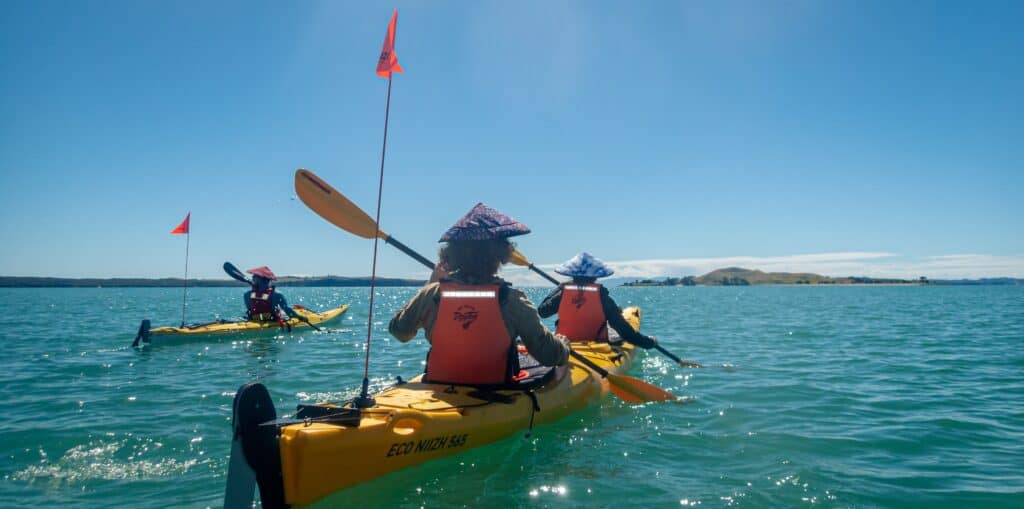
The Call of the Sea: Sea Kayaking Adventures
For those seeking adventure, the Browns Island Sea Kayak Tour to Motukorea provides a unique perspective on the island’s geological and historical features. Paddling along the island’s rugged coastline, kayakers can explore hidden coves, rocky outcrops, and the remnants of ancient lava flows. The journey offers a rare opportunity to see the island as early Māori and European explorers might have, from the vantage point of the water.
The island’s proximity to Auckland (only 4km / 45mins from St Heliers Beach) makes it an accessible destination for day trips, yet it retains an air of remoteness, offering kayakers a sense of solitude and connection with nature. The calm waters of the Hauraki Gulf are ideal for both novice and experienced kayakers, providing a safe and enjoyable environment to explore the island’s many hidden treasures where only the windy weather is the challenge.
Conservation and Preservation: A Delicate Balance
Browns Island Motukorea’s rich cultural and natural heritage has led to ongoing efforts to preserve its unique landscape. The island’s inclusion in the Hauraki Gulf Marine Park and its designation as a public reserve reflect the importance of safeguarding its archaeological and ecological features. However, balancing conservation with public access remains a challenge.
The island’s management plan emphasizes the need for responsible tourism, ensuring that visitor activities do not compromise the integrity of the archaeological sites or the natural environment. Grazing concessions, careful monitoring of visitor impact, and periodic vegetation clearing are among the strategies employed to maintain the island’s historic landscape.
A Journey Through Time
Motukorea (Browns Island) is more than just a volcanic island in the Hauraki Gulf; it is a living testament to the geological, cultural, and historical forces that have shaped Auckland. Whether you are drawn to its explosive past, its role in the early settlement of New Zealand, or its tranquil beaches and bays, the island offers something for everyone.
For sea kayakers, Browns Island Motukorea is a destination that combines adventure with education, offering a chance to paddle through history while enjoying the stunning natural beauty of the Hauraki Gulf. For historians and archaeologists, it is a site of immense significance, preserving the legacy of both Māori and European settlers. And for conservationists, it is a reminder of the delicate balance required to protect our natural and cultural heritage.
A visit to Motukorea is a journey through time, where every bay, beach, and volcanic cone tells a story of the past, waiting to be discovered.
Mat rentals have become popular as the bouldering community grows and more climbers seek to explore the diverse and challenging bouldering spots in and around the Auckland region. Offering convenience and safety, SNM provide climbers with essential gear, making climbing adventures accessible and enjoyable. Among our top-rated gear, medium mats are available for $20 per day, while large mats can be hired for $30 per day. This affordability and ease of access make bouldering more attainable for both seasoned climbers and beginners.
Wairere Boulders, located in Northland, is a premier bouldering destination known for its unique geological formations. The boulders here offer a range of difficulties, catering to all skill levels. The lush surroundings add to the experience, making it a favorite among climbers seeking both challenge and beauty.
Stony Batter, situated on Waiheke Island, combines historical intrigue with excellent bouldering opportunities. The large, scattered boulders provide diverse climbing routes, from beginner to advanced levels. The scenic ferry ride to Waiheke Island adds an element of adventure, making it a must-visit spot for bouldering enthusiasts. Check out the Waiheke Bouldering Guide Here
Waipari, located in Wharepapa South, is renowned for its ignimbrite pocket climbing. This volcanic rock offers unique holds and challenging routes. The area’s rugged beauty and the variety of climbing problems make it a top choice for climbers looking for a distinctive and rewarding bouldering experience. Check out the Waipari Bouldering Guide here.
The Air Strip in Waitomo is a hidden gem for bouldering, featuring a variety of boulders scattered across a picturesque landscape. The location’s relative seclusion and the quality of the climbs attract bouldering enthusiasts seeking a peaceful yet challenging environment. The natural beauty of Waitomo, with its famous caves and lush greenery, provides an excellent backdrop for a day of climbing.
A boulder mat, also known as a crash pad, is a crucial piece of equipment for any boulderer. These mats are designed to provide safety and comfort during falls, making outdoor climbing and bouldering safer and more enjoyable.
A boulder mat functions by absorbing the impact of a fall, spreading the force across the mat’s surface. This reduces the stress on the climber’s body and minimizes the risk of injury. High-quality mats maintain their cushioning ability even after repeated use.
Using a boulder mat is straightforward, but proper placement is key to ensuring safety. Here are some tips:
A spotter plays a vital role in bouldering, ensuring the climber lands on the mat correctly and safely. Here’s how to spot effectively:
Boulder mat hire services in Auckland provide climbers with the necessary gear to enjoy bouldering safely and conveniently. With affordable rates of $20 per day for medium mats and $30 per day for large mats, these services make bouldering accessible to everyone. Popular bouldering spots like Wairere Boulders, Stony Batter, Waipari, and The Air Strip offer diverse challenges and beautiful settings for climbers of all levels.
In summary, whether you’re an experienced climber or a beginner, boulder mat hire services in Auckland provide the equipment and support needed to explore the region’s fantastic bouldering spots safely and enjoyably.
Tāwharanui Regional Park Open Sanctuary, located just north of Auckland, is one of the few places where you can encounter the elusive and iconic wild kiwi bird in its natural habitat. This pristine sanctuary offers a unique blend of conservation efforts and visitor experiences, making it a prime destination for wildlife enthusiasts and nature lovers. If you’re wondering, “Where can I see a kiwi in Auckland?” look no further than Tāwharanui. Alongside your authentic kiwi adventure, the park offers exceptional stargazing opportunities and the option to enjoy a luxurious glamping experience, ensuring an unforgettable visit.
Tāwharanui Regional Park is a predator-free sanctuary that provides a safe haven for the North Island brown kiwi. The park’s diverse ecosystems, including coastal forests, wetlands, and open pasturelands, create an ideal environment for these nocturnal birds. The best places to spot real kiwi within the park include:
In addition to wild kiwi spotting, Tāwharanui offers exceptional stargazing opportunities. The park’s remote location, away from the city lights of Auckland, ensures dark skies ideal for stargazing. Here’s how to enhance your visit with a celestial experience:
For those looking to extend their stay and fully immerse themselves in the natural beauty of Tāwharanui, glamping is an excellent option. The SNM team offers luxury tents equipped with comfortable amenities, allowing you to enjoy the great outdoors without sacrificing comfort. Here’s what you need to know about glamping at Tāwharanui:
Tāwharanui Regional Park Open Sanctuary is a premier destination for those seeking to see wild kiwi in Auckland. The combination of successful conservation efforts, guided night walks, and the park’s natural beauty make it an ideal place to encounter these unique birds in the wild. Adding a stargazing tour and optional glamping experience enhances your visit, providing a perfect blend of adventure, education, and relaxation. Whether you’re a local or a visitor, a trip to Tāwharanui promises unforgettable memories and a deeper appreciation for New Zealand’s remarkable wildlife. So, pack your gear, book your tours, and get ready to embark on an extraordinary journey where you can truly answer the question, “Where can I see a kiwi in Auckland?” with an experience that goes beyond expectations.
New Zealand is renowned for its pure and stunning natural landscapes, which include a variety of Natural Wonders. Here’s a compilation of some of the most notable wonders:
Milford Sound: Often referred to as the Eighth Wonder of the World, Milford Sound is a breathtaking fjord located in Fiordland National Park. It features towering cliffs, cascading waterfalls, and pristine waters, making it a popular destination for cruises, kayaking, and hiking. It is only one of two UNESCO listed sites in New Zealand.
Tongariro National Park: This UNESCO World Heritage Site is home to three active volcanoes, including Mount Ruapehu, Mount Ngauruhoe (also known as Mount Doom from “The Lord of the Rings” movies), and Mount Tongariro. The park offers diverse landscapes, including volcanic peaks, crater lakes, and alpine meadows, along with the famous Tongariro Alpine Crossing, one of New Zealand’s most popular day hikes.
Fiordland National Park: In addition to Milford Sound, Fiordland National Park encompasses a vast wilderness area characterized by its raw and rugged mountains, deep fjords, and ancient forests. The park is a haven for outdoor enthusiasts, offering opportunities for hiking, kayaking, and wildlife viewing.
Pancake Rocks and Blowholes: Located on the West Coast of the South Island, near the town of Punakaiki, the Pancake Rocks are limestone formations that have been sculpted over time by the sea, resembling stacks of pancakes. During high tide, blowholes in the rocks create impressive water spouts, adding to the area’s spectacle.
Rotorua Geothermal Area: Rotorua is known for its geothermal activity, with geysers, hot springs, and mud pools scattered throughout the region. Wai-O-Tapu Thermal Wonderland is a popular attraction within Rotorua, featuring colorful mineral pools, while Te Puia offers cultural experiences alongside geothermal wonders.
Fox and Franz Josef Glaciers: These iconic glaciers on the West Coast of the South Island are among the most accessible glaciers in the world. Visitors can take guided walks, helicopter tours, or even heli-hikes to explore the icy landscapes and witness the dynamic forces of nature at work.
Abel Tasman National Park: Located at the northern tip of the South Island, Abel Tasman National Park boasts golden beaches, turquoise waters, and lush coastal forests. The Abel Tasman Coast Track is a renowned multi-day hiking trail that offers stunning views and opportunities for swimming, kayaking, and wildlife spotting.
Lake Tekapo and the Mackenzie Basin: Known for its incredibly clear night skies, Lake Tekapo is surrounded by the stunning landscapes of the Mackenzie Basin. Visitors can enjoy stargazing at the Mt. John Observatory, take scenic drives through the high country, or simply relax by the tranquil lake.
Whanganui River: The Whanganui River is the third-longest river in New Zealand and holds great cultural significance to the Maori people. Visitors can explore the river by kayak or canoe, immersing themselves in the serene beauty of the Whanganui National Park and experiencing Maori culture along the way.
These natural wonders only scratch the surface of New Zealand’s diverse and awe-inspiring landscapes. Whether you’re drawn to its snow-capped mountains, pristine beaches, or lush rainforests, New Zealand offers something for every nature lover to marvel at and explore.
Additionally, New Zealand is renowned for its Unique Nature, many of which are found only in this isolated island nation. Here’s a closer look at some of these remarkable features, why they’re exclusive to New Zealand, and what makes them so wonderful:
Kauri Trees: The Kauri trees are massive, ancient conifers native to New Zealand’s North Island. They are among the largest trees in the world by volume and can live for over 2,000 years. Kauri forests once covered much of the North Island, but today, only a few significant stands remain, making them a precious and unique natural wonder. Their grandeur and cultural significance to the indigenous Māori people add to their marvel. The crude extraction of resin from these majestic giants in the past also shaped the history of the region.
Geothermal Wonders: New Zealand is a geologically active country, with numerous geothermal features found nowhere else. This includes geysers, hot springs, mud pools, and fumaroles. The country’s location on the Pacific Ring of Fire, where tectonic plates collide, results in high levels of geothermal activity. Places like Rotorua, Taupo, and the central North Island are hotspots for these geothermal wonders, offering visitors a glimpse into the Earth’s fiery depths.
Endemic Flora and Fauna: New Zealand’s isolation, both geographically and temporally, has led to the evolution of unique flora and fauna found nowhere else on Earth. Examples include the flightless kiwi bird, the ancient tuatara reptile, and the iconic silver fern. The absence of mammalian predators for millions of years allowed birds to flourish, resulting in a plain array of unique avian species like the kakapo and the takahe. This unparalleled biodiversity inspires admiration, astonishment, and awe, reflecting the wild beauty of New Zealand’s natural heritage as a whole.
Fiords and Sounds: The fiords and sounds of New Zealand’s South Island, particularly in Fiordland National Park, are breathtaking natural wonders shaped by ancient glaciers. Milford Sound and Doubtful Sound are among the most famous, with sheer cliffs rising from the dark waters, cascading waterfalls, and lush rainforests. These dramatic landscapes are the result of a combination of geological processes and the region’s high rainfall, creating a truly awe-inspiring environment. Exploring these majestic landscapes ignites curiosity, fascination, and surprise, leaving visitors marveling at the wonders of nature.
Waitomo Glowworm Caves: The Waitomo Glowworm Caves are a unique underground attraction on the North Island, known for their magical bioluminescent glowworms. These tiny creatures, Arachnocampa luminosa, emit a blue-green light to attract prey, creating a mesmerizing starry effect on the cave ceilings. The caves formed over millions of years through the action of water on limestone, but it’s the glowworms that make this natural wonder truly extraordinary. Exploring these caves often evokes perplexity, puzzlement, and a sense of wonderment, leaving visitors in a state of awe and curiosity about the mysteries of nature.
White Island: As New Zealand’s only active marine volcano, White Island (Whakaari) is a fascinating and dynamic natural wonder. Located in the Bay of Plenty, it features steaming vents, acidic crater lakes, and rugged landscapes shaped by ongoing volcanic activity. Observers can witness the raw power of the Earth firsthand, making it a thrilling and unforgettable observation. Exploring White Island is no longer allowed but still fulfills people with wonder and curiosity as they marvel at the miracle of nature’s creation, surrounded by the oddity of an active volcano amidst the sea.
These natural wonders are not only exclusive to New Zealand but also hold cultural, ecological, and geological significance. Their uniqueness adds to their allure, attracting visitors from around the world to marvel at the wonders of this remote corner of the Earth.
New Zealand also has two Dark Sky Sanctuary sites:
Great Barrier Island (GBI), or “Aotea” to Māori, lies northeast of Auckland in New Zealand. Initially exploited for resources, its 1,000 residents now rely on agriculture and tourism. GBI’s slow pace and preserved natural darkness, with 60% as a nature reserve, attract those seeking an untouched environment. Designated in 2017, it’s a Dark Sky Sanctuary.
Stewart Island-Rakiura, New Zealand’s third-largest island, hosts 390 residents and is predominantly protected as Rakiura National Park. Its remoteness and sparse population contribute to exceptionally dark skies, ideal for stargazing. Designated an International Dark Sky Sanctuary in 2019, it offers a rare experience of pristine nocturnal vistas.
Here’s more about each of the Unique Natural Places in New Zealand:
Tongariro Alpine Crossing: A challenging hiking trail through Tongariro National Park, passing volcanic landscapes, emerald lakes, and offering stunning views of Mount Ngauruhoe.
Lake Matheson: Renowned for its mirror-like reflections of Aoraki/Mount Cook and Mount Tasman, creating stunning photographic opportunities in the South Island’s West Coast region.
Moeraki Boulders: Unique spherical boulders scattered along Koekohe Beach, believed to have formed millions of years ago, attracting photographers and curious visitors.
Huka Falls: A powerful waterfall on the Waikato River near Taupo, where turquoise water thunders through a narrow gorge, creating an impressive natural spectacle.
Tane Mahuta: A giant kauri tree in Waipoua Forest, estimated to be over 2,000 years old, revered as the largest living kauri tree in New Zealand.\
Blue Pools: Crystal-clear pools fed by glacier meltwater, located near Haast Pass in Mount Aspiring National Park, offering refreshing swimming spots and scenic walks.
Waiheke Island: A picturesque island near Auckland, famous for its vineyards, olive groves, and stunning beaches, offering a relaxing getaway with scenic walks and boutique accommodation.
Hot Water Beach: A unique beach on the Coromandel Peninsula where visitors can dig their own hot pools in the sand at low tide, enjoying natural hot spring bathing.
Lake Wanaka: Surrounded by mountains and offering panoramic views, this South Island lake is popular for water sports, scenic flights, and hiking, including the famous Roy’s Peak Track.
Marlborough Sounds: A network of sea-drowned valleys renowned for its stunning scenery, offering opportunities for boating, kayaking, and hiking in the top of the South Island.
Mount Cook: New Zealand’s highest peak, surrounded by the spectacular landscapes of Aoraki/Mount Cook National Park, offering hiking, mountaineering, and scenic flights.
Wharariki Beach: A wild and windswept beach on the northern coast of the South Island, known for its dramatic rock formations, sea arches, and resident seal colony.
Boulder Bank: A natural landform consisting of a long, narrow accumulation of large boulders, extending from Nelson’s port entrance into Tasman Bay, offering unique coastal scenery.
The Tree Church: Located in Ohaupo, Waikato, this living church is formed by carefully shaped trees, offering a serene and enchanting environment for weddings and events.
Cape Reinga: The northernmost tip of New Zealand, where the Tasman Sea and Pacific Ocean meet, known for its cultural significance and stunning coastal views.
These places showcase the diverse and stunning natural beauty of New Zealand, attracting visitors from around the world.
Here’s a compilation and summary of the three UNESCO World Heritage sites in New Zealand:
Tongariro National Park
Location: Manawatū-Whanganui
Designation: Mixed (Cultural and Natural)
Inscribed: 1990, 1993
Significance: Tongariro became the first property on the World Heritage List recognized for its cultural landscape. The mountains hold immense cultural and religious importance for the Māori, symbolizing their spiritual connection to the land. The park features active and extinct volcanoes, diverse ecosystems, and stunning landscapes. Te Wahipounamu – South West New Zealand Location: Otago, Southland, West Coast Designation: Natural Inscribed: 1990 Significance: This park in southwest New Zealand showcases a landscape shaped by glaciations, featuring fjords, rocky coasts, cliffs, lakes, and waterfalls. Covered with ancient southern beech and podocarp forests, it’s home to unique wildlife including the kea (alpine parrot) and the rare takahe (large flightless bird).
New Zealand Sub-Antarctic Islands
Location: New Zealand Subantarctic Islands
Designation: Natural
Inscribed: 1998
Significance: Comprising five island groups in the Southern Ocean southeast of New Zealand, these islands boast high productivity, biodiversity, and wildlife populations. Notable for their pelagic seabirds and penguins, they host 126 bird species, including eight seabirds found nowhere else.
Embarking on an outdoor bouldering adventure on Waiheke Island, Auckland, presents a blend of exhilarating physical challenge, breathtaking natural scenery, and a welcoming community vibe. This bouldering guide, aims to equip you with all the necessary information to fully immerse yourself in this unique experience.
Waiheke Island’s bouldering spots offer not just a physical challenge but also a chance to connect deeply with nature and a community of like-minded enthusiasts. It’s an opportunity to test your limits, enjoy serene landscapes, and be part of a rich, engaging outdoor culture.
Reiterate the unique blend of challenging climbs, stunning natural surroundings, and a vibrant community that makes Waiheke Island an exceptional destination for boulderers.
A blue moon refers to the occurrence of an additional full moon within a calendar month. Typically, a calendar month has one full moon, but occasionally, due to the misalignment between the lunar month (which lasts about 29.5 days) and the calendar month (which typically lasts 30 or 31 days), there can be two full moons in a single month.
The term “blue moon” has been used for centuries, though its modern definition as the second full moon in a calendar month gained popularity in the latter half of the 20th century. This definition was popularized by an article in the March 1946 issue of Sky & Telescope magazine, and it has since become widely known.
The phrase “once in a blue moon” is also commonly used in English to describe something that happens very rarely or infrequently, perhaps because blue moons themselves are relatively rare occurrences, happening about once every 2 to 3 years on average.
It’s important to note that despite the name, a blue moon does not actually appear blue in color. The term “blue” here is used in its older sense, meaning “rare” or “unusual,” rather than referring to the moon’s color. However, there are rare atmospheric conditions, such as volcanic eruptions or wildfires, that can cause the moon to appear blue in color. This phenomenon is unrelated to the astronomical definition of a blue moon.
Expereince our full moon tours!
The term “blue moon” traditionally refers to the phenomenon of having two full moons occur within the same calendar month. This occurrence is relatively rare, happening roughly once every 2.7 years. The phrase “blue moon” has its origins in folklore, where it was used to describe something that was rare or unusual, much like the idea of “once in a blue moon.”
Interestingly, the term “blue moon” doesn’t actually refer to the color of the moon. While the moon can sometimes appear to have a bluish hue due to atmospheric conditions such as smoke or dust particles, a “blue moon” is not inherently blue in color. It’s simply a name given to the second full moon in a calendar month.
Matariki, also known as the Māori New Year, is a significant cultural event for the indigenous Māori people of New Zealand. It marks the appearance of the cluster of stars known as the Pleiades or Seven Sisters in the sky, which typically occurs in late May or early June in the Southern Hemisphere. Matariki is celebrated with various cultural and spiritual practices, including gatherings, feasting, storytelling, and reflection. It holds great importance as a time for remembering the past, celebrating the present, and looking towards the future.
Matariki, also known as the Pleiades star cluster, holds significant cultural and astronomical importance for many indigenous peoples of the South Pacific, including the Māori people of New Zealand. Here’s how you can find Matariki:
Remember, while Matariki holds special importance for Māori and other indigenous peoples, it’s a beautiful celestial event that anyone can appreciate.
The Duke of Edinburgh Award Adventurous Journey support.
Embarking on your Award journey is an adventure awaiting your discovery, and we understand that financial barriers shouldn’t stand in the way of your dreams.
That’s why we’re here to offer you a range of grants, scholarships, and financial assistance options tailored to support you every step of the way.
$50 training
Bronze practice ($150) and qualifier ($250)
Silver practice ($125) and qualifier ($200)
Gold practice ($100) and qualifier ($150)
Beyond fees, we extend limited support for Adventurous Journeys and other pivotal areas of your Award journey.
With the generosity of the Social Nature Movement, we provide funds for travel, accommodations, meals, and gear hire, enabling you to focus solely on your expedition.
At every turn, we strive to ensure that financial considerations never dim the brilliance of your Award journey.
Nestled within the sparkling waters of the Hauraki Gulf, Auckland boasts more than 25 islands, each offering a unique blend of natural wonders, cultural heritage, and immersive experiences. From the rugged coastlines of Rangitoto to the tranquil bays of Waiheke, the Hauraki Gulf Auckland Islands beckon adventurers and nature enthusiasts alike to embark on a journey of discovery and exploration.
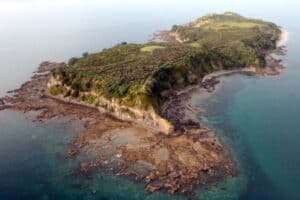
Hauraki derives from the Maori words ‘hau’ signifying ‘north’ and ‘raki’ meaning wind. This could imply the geographical reality that the Hauraki Gulf Auckland Islands are encircled by land to the East, South, and West, leaving it predominantly open to the North.
Sheltered by the extended reach of the Coromandel Peninsula and the nearby Great Barrier Island, the waters of the Gulf teem with snapper, kahawai, and vigorous kingfish, serving as a spawning site for sharks. It is also a habitat for bottlenose and common dolphins, the majestic orca, and the impressive Bryde’s whale.
The coastal marine region was flanked by vast estuaries, wetlands, and verdant coastal forests, creating a fertile sanctuary for both terrestrial and aquatic species. The Hauraki Gulf Auckland Islands boast a deeply storied human past, being among the initial areas inhabited by the Māori people.
Auckland Island (known as Mauka Huka in Māori) serves as the principal landmass of the unpopulated archipelago bearing its name, nestled within the Pacific Ocean and forming part of New Zealand’s subantarctic territory. It holds a place on the UNESCO World Heritage list alongside the neighboring New Zealand Subantarctic Islands. However, the Islands of – and within – Auckland and the Hauraki Gulf are mostly inhabited.
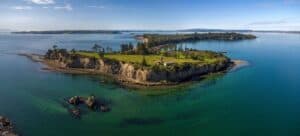
One of Auckland’s most iconic landmarks, Rangitoto Island is a volcanic masterpiece, rising majestically from the sea. Trekking to the summit of Rangitoto offers unparalleled views of the Hauraki Gulf Auckland Islands, making it a must-visit for hikers and photographers. Explore island things to do with lava caves and rugged terrain, or simply relax on its black sand beaches, soaking in the tranquility of this unique natural sanctuary.
Renowned for its picturesque vineyards and golden beaches, Waiheke Island is a haven for wine enthusiasts and beach lovers alike. Embark on a wine tasting tour of the island’s boutique wineries, sampling award-winning varietals against the backdrop of sweeping coastal vistas. Alternatively, spend your days basking in the sunshine on one of Waiheke’s pristine beaches, or hiking through its lush native bushland in search of hidden coves and panoramic viewpoints.
For those seeking a truly off-the-grid adventure, Great Barrier Island offers an unparalleled escape into the heart of nature. With vast tracts of pristine wilderness and crystal-clear waters teeming with marine life in the Hauraki Gulf Auckland Islands, Great Barrier is a paradise for outdoor enthusiasts. Explore the island’s network of hiking trails, kayak through its sheltered bays, or dive beneath the waves to discover colourful reefs and underwater caves. With limited development and a strong focus on conservation, Great Barrier Island offers a rare opportunity to reconnect with the natural world and experience the true essence of sustainable tourism.
Motutapu Island:
Steeped in Maori history and cultural significance, Motutapu Island is a treasure trove of archaeological sites and sacred landmarks. Embark on a guided tour of the island to learn about its rich cultural heritage, from ancient pa sites to traditional Maori gardens. Participate in cultural workshops and performances, or simply immerse yourself in the tranquility of this sacred landscape, where the past meets the present in a seamless blend of history and tradition.
Motuihe Island:
With its pristine beaches and sheltered bays, Motuihe Island is a paradise for water sports enthusiasts and beachgoers. Spend your days swimming, snorkelling, or paddleboarding in the crystal-clear waters of the Hauraki Gulf Auckland Islands, or simply relax on the sandy shores and soak up the sunshine. For those interested in conservation, Motuihe Island also offers the opportunity to participate in community-led restoration projects, helping to protect and preserve its fragile ecosystems for future generations to enjoy.
Tiritiri Matangi Island:
Known for its thriving birdlife and lush native forests, Tiritiri Matangi Island is a birdwatcher’s paradise. Home to rare and endangered species such as the kokako and the takahe, the island offers visitors the chance to observe these magnificent creatures in their natural habitat. Join a guided birdwatching tour or explore the island’s network of walking tracks, keeping an eye out for the colourful plumage and melodious calls of its resident avian inhabitants.
Kawau Island:
With its sheltered coves and historic mansion, Kawau Island exudes old-world charm and tranquility. Explore the island’s rich maritime history at Mansion House, once the residence of New Zealand’s first governor, Sir George Grey, and now a museum and heritage site. Take a scenic cruise around the island’s picturesque coastline, spotting dolphins and other marine life along the way, or simply relax on the deck of a chartered yacht as you soak up the serenity of this idyllic island retreat.
Rakino Island:
A hidden gem tucked away in the Hauraki Gulf Auckland Islands, Rakino Island is a paradise for nature lovers and outdoor enthusiasts. Explore its rugged coastline on foot, discovering secluded beaches and panoramic viewpoints along the way, or take to the water and kayak through its sheltered bays and crystal-clear waters. With no shops or facilities, Rakino Island offers a true escape from the hustle and bustle of modern life, where you can reconnect with nature and immerse yourself in the simple pleasures of island living.
Little Barrier Island (Hauturu):
As one of New Zealand’s most important nature reserves, Little Barrier Island (Hauturu) is a haven for native wildlife and conservation efforts. Home to rare and endangered species such as the kiwi and the kaka, the island is carefully managed to protect its fragile ecosystems and unique biodiversity. Join a guided tour to learn about the island’s conservation projects and scientific research, or explore its pristine beaches and lush rainforest on a self-guided hike. With no permanent human habitation, Little Barrier Island offers a rare opportunity to experience the wonders of untouched nature in a truly remote and unspoiled setting.
Browns Island (Motukorea):
With its volcanic cone and panoramic views of the Auckland skyline, Browns Island (Motukorea) is a popular destination for day-trippers and outdoor enthusiasts. Explore the island’s rugged coastline and volcanic formations, or hike to the summit for breathtaking vistas of the surrounding Waitemata Harbour and beyond. One of the easiest Hauraki Gulf Auckland Islands to enjoy a picnic on the grassy slopes overlooking the sea, or take a dip in the sheltered coves and sandy beaches that fringe the island’s shores. With its rich history and natural beauty, Browns Island offers a unique opportunity to experience the best of Auckland’s coastal landscapes in one unforgettable day trip.
Pakatoa (Chamberlain) Island:
Nestled in the heart of the Auckland Islands, Pakatoa Island is a secluded oasis of pristine beaches and lush tropical gardens. Accessible only by boat or helicopter, the island offers a true escape from the hustle and bustle of city life, where you can unwind and reconnect with nature in complete seclusion. Stay in one of the island’s charming beachfront cottages or luxury villas, and spend your days swimming, snorkelling, or simply relaxing on the sun-drenched shores. With its untouched beauty and tranquil atmosphere, Pakatoa Island is the perfect destination for a romantic getaway or peaceful retreat.
Pakihi Island:
Pakihi Island, privately owned and situated in the Hauraki Gulf east of Auckland, New Zealand, spans 114 hectares. It is one of the smaller islands in the Hauraki Gulf, located southwest of Ponui Island and offshore from Waitawa Regional Park. The island’s land use primarily consists of pastoral activities, plantations, and areas of native vegetation. Purchased by the McCallum family in 1894 from Sir John Logan Campbell, the island has historical significance, serving as a site for quarrying red chert from 1906 to 1927. The quarried material was extensively used in creating concrete structures in Auckland, and the island’s wharf hosted the first iron ship built in the city, the 1876 Rotomahana.
Karamuramu Island:
Karamuramu Island, privately owned and situated in the Hauraki Gulf east of Auckland, New Zealand, spans approximately 6.5 hectares. It hosts a quarry extracting red-colored chert, known as “McCallum chip,” utilized primarily in decorative red concrete. Purchased in 1894 by the McCallum family from Sir John Logan Campbell, the island has historical significance dating back to the establishment of a quarry in 1908. The McCallum family continues to oversee mining operations, with the red stone contributing to various Auckland landmarks, including Grafton Bridge and Auckland Motorway shoulders.
Ponui Island:
With its rolling hills and sweeping coastal vistas, Ponui Island is a tranquil haven for nature lovers and outdoor enthusiasts. Explore its network of walking tracks, which wind their way through native bushland and along the rugged coastline, offering stunning views of the surrounding Hauraki Gulf Auckland Islands and beyond. Spend your days fishing, swimming, or kayaking in the crystal-clear waters that fringe the island’s shores, or simply relax on the sandy beaches and soak up the sunshine. With its untouched beauty and peaceful atmosphere, Ponui Island is the perfect destination for a weekend escape or extended holiday.
Rotoroa Island:
Once home to a rehabilitation centre for alcoholics, Rotoroa Island has been transformed into a sanctuary for native wildlife and conservation efforts. Explore its network of walking tracks, which wind their way through lush native bushland and along rugged coastline, offering stunning views of the surrounding Hauraki Islands and beyond. Visit the island’s museum and art gallery to learn about its rich history and cultural significance, or simply relax on the sandy beaches and soak up the sunshine. With its tranquil atmosphere and natural beauty, Rotoroa Island offers a unique opportunity to reconnect with nature and experience the wonders of New Zealand’s coastal landscapes.
Te Haupa Island:
Te Haupa Island is a small, uninhabited island located just off the coast of Auckland. With its rugged coastline and pristine beaches, it offers a peaceful retreat from the hustle and bustle of city life. Spend your days exploring the island’s secluded coves and rocky outcrops, or simply relax on the sandy shores and soak up the sunshine. Te Haupa Island is also a popular destination for fishing and snorkelling, with crystal-clear waters teeming with marine life. Whether you’re seeking adventure or simply looking to unwind, Te Haupa Island offers a serene escape into the beauty of the natural world.
Motukorea Island:
Also known as Browns Island, Motukorea Island is a volcanic cone rising majestically from the waters of the Auckland Gulf. Explore its rugged coastline and volcanic formations, or hike to the summit for panoramic views of the surrounding islands and beyond. Motukorea Island is also home to a number of archaeological sites, including Maori pa sites and terraces, providing insight into the island’s rich cultural history. With its natural beauty and cultural significance, Motukorea Island offers a unique opportunity to explore the wonders of Auckland’s coastal landscapes and learn about its indigenous heritage.
Motuhoropapa Island:
Motuhoropapa Island is a small, uninhabited island located in the Hauraki Gulf Auckland Islands. With its pristine beaches and crystal-clear waters, it offers a peaceful retreat from the hustle and bustle of city life. Spend your days swimming, snorkelling, or simply relaxing on the sandy shores and soaking up the sunshine. Motuhoropapa Island is also home to a variety of native bird species, making it a popular destination for birdwatching enthusiasts. Whether you’re seeking adventure or simply looking to unwind, Motuhoropapa Island offers a serene escape into the beauty of the natural world.
Motuketekete Island:
Motuketekete Island is a small, uninhabited island located off the coast of Auckland. With its rugged coastline and pristine beaches, it offers a peaceful retreat from the hustle and bustle of city life. Spend your days exploring the island’s secluded coves and rocky outcrops, or simply relax on the sandy shores and soak up the sunshine. Motuketekete Island is also a popular destination for fishing and snorkelling, with crystal-clear waters teeming with marine life. Whether you’re seeking adventure or simply looking to unwind, Motuketekete Island offers a serene escape into the beauty of the natural world.
Pūtiki Bay Island (Kawau Island):
Pūtiki Bay Island is a small, uninhabited island located near Kawau Island in the Hauraki Gulf Auckland Islands. With its pristine beaches and crystal-clear waters, it offers a peaceful retreat from the hustle and bustle of city life. Spend your days swimming, snorkelling, or simply relaxing on the sandy shores and soaking up the sunshine. Pūtiki Bay Island is also home to a variety of native bird species, making it a popular destination for birdwatching enthusiasts. Whether you’re seeking adventure or simply looking to unwind, Pūtiki Bay Island offers a serene escape into the beauty of the natural world.
Mahurangi Island:
Mahurangi Island is a small, uninhabited island located in the Mahurangi Harbour. With its rugged coastline and pristine beaches, it offers a peaceful retreat from the hustle and bustle of city life. Spend your days exploring the island’s secluded coves and rocky outcrops, or simply relax on the sandy shores and soak up the sunshine. Mahurangi Island is also home to a variety of native bird species, making it a popular destination for birdwatching enthusiasts. Whether you’re seeking adventure or simply looking to unwind, Mahurangi Island offers a serene escape into the beauty of the natural world.
Noises Islands:
The Noises Islands are a group of small, uninhabited islands located in the Hauraki Gulf Auckland Islands. With their rugged coastlines and pristine beaches, they offer a peaceful retreat from the hustle and bustle of city life. Spend your days exploring the islands’ secluded coves and rocky outcrops, or simply relax on the sandy shores and soak up the sunshine. The Noises Islands are also home to a variety of native bird species, making them a popular destination for birdwatching enthusiasts. Whether you’re seeking adventure or simply looking to unwind, the Noises Islands offer a serene escape into the beauty of the natural world.
Araotonga Island:
Araotonga Island is a small, uninhabited island located in the Hauraki Gulf Auckland Islands. With its rugged coastline and pristine beaches, it offers a peaceful retreat from the hustle and bustle of city life. Spend your days exploring the island’s secluded coves and rocky outcrops, or simply relax on the sandy shores and soak up the sunshine. Araotonga Island is also home to a variety of native bird species, making it a popular destination for birdwatching enthusiasts. Whether you’re seeking adventure or simply looking to unwind, Araotonga Island offers a serene escape into the beauty of the natural world.
Whanganui Island:
Whanganui Island is a small, uninhabited island located in the Hauraki Gulf Auckland Islands. With its rugged coastline and pristine beaches, it offers a peaceful retreat from the hustle and bustle of city life. Spend your days exploring the island’s secluded coves and rocky outcrops, or simply relax on the sandy shores and soak up the sunshine. Whanganui Island is also home to a variety of native bird species, making it a popular destination for birdwatching enthusiasts. Whether you’re seeking adventure or simply looking to unwind, Whanganui Island offers a serene escape into the beauty of the natural world.
Tāpuaetai (Goat Island):
Tāpuaetai, commonly known as Goat Island, is a small, uninhabited island located in the Hauraki Gulf Auckland Islands. With its rugged coastline and pristine beaches, it offers a peaceful retreat from the hustle and bustle of city life. Spend your days exploring the island’s secluded coves and rocky outcrops, or simply relax on the sandy shores and soak up the sunshine. Tāpuaetai is also home to a variety of native bird species, making it a popular destination for birdwatching enthusiasts. Whether you’re seeking adventure or simply looking to unwind, Tāpuaetai offers a serene escape into the beauty of the natural world.
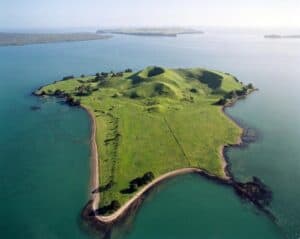
The Hauraki Gulf Auckland Islands offer a diverse range of experiences, from hiking and wildlife viewing to cultural exploration and relaxation. Embark on an island-hopping adventure and discover the beauty and wonder of Auckland’s islands.
Introduction: Auckland, nestled on New Zealand’s North Island, boasts not only a stunning cityscape but also a diverse natural environment of forests and many other habitats. Among its ecological treasures, Auckland mangroves play a vital role in supporting biodiversity, shoreline stability, and providing unique recreational opportunities . In this comprehensive guide, we will delve into the benefits and features of Auckland’s mangroves. From their ecological significance to the immersive experiences they offer, this exploration aims to showcase the value of these coastal ecosystems.
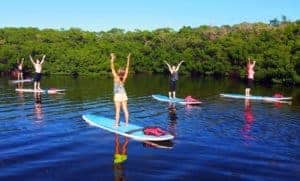
Species Diversity:
Auckland’s mangroves are primarily dominated by two species – Avicennia marina and Avicennia resinifera. These hardy species have adapted to the intertidal zone, thriving in the challenging conditions where land meets sea.
Intertidal Habitat:
Auckland Mangroves thrive in the intertidal zone, the area between high and low tides. This unique habitat provides a crucial transition zone for various marine and terrestrial species, fostering biodiversity.
Root Systems:
The distinctive prop roots of mangroves serve multiple functions. They provide stability to the trees in the soft substrate, offer a refuge for juvenile fish, and create a complex network that supports diverse marine life.
Tidal Influence:
Auckland’s mangroves experience the rhythmic ebb and flow of tides. This tidal influence plays a significant role in nutrient exchange, sediment deposition, and the overall health of the mangrove ecosystem.
Adaptations to Salinity:
Mangroves have evolved unique adaptations to survive in saline environments. They can filter out salt through specialized glands, allowing them to thrive in brackish waters.
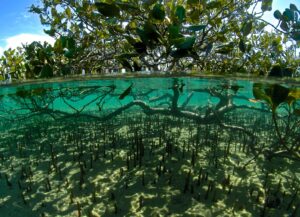
Biodiversity Hotspot:
Auckland’s mangroves serve as crucial nurseries for various fish and invertebrates. The intricate root systems provide shelter and food for juvenile marine life, contributing to the overall health of the coastal ecosystem.
Erosion Control:
The dense root systems of mangroves act as a natural barrier against erosion. They stabilize coastlines, reducing the impact of storm surges and protecting vulnerable habitats.
Water Quality Improvement:
Mangroves act as natural filters, trapping sediments and pollutants. This filtration process enhances water quality, benefiting both marine life and human communities that rely on these coastal waters.
Carbon Sequestration:
Mangroves play a crucial role in sequestering carbon. The organic material that accumulates in their sediments over time locks away carbon, mitigating the impacts of climate change.
Recreational Opportunities:
Auckland’s mangroves offer unique recreational opportunities for nature enthusiasts. Kayaking through mangrove-lined waterways provides an immersive experience, allowing individuals to connect with nature and appreciate the beauty of these ecosystems.
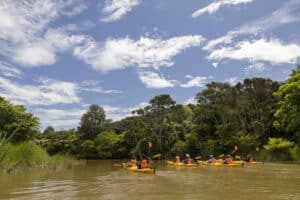
Are Auckland mangroves invasive?
Auckland’s mangroves are native to the region and play a vital ecological role. However, some concerns about invasive species and management practices may arise, necessitating careful monitoring and conservation efforts.
Do Auckland mangroves attract mosquitoes?
While mangroves themselves do not attract mosquitoes, stagnant water in nearby areas might. Proper management and maintenance can help mitigate potential mosquito issues.
Can you walk through Auckland mangroves?
Some areas with boardwalks or designated trails allow visitors to explore Auckland’s mangroves on foot. It’s essential to follow designated paths to minimize disturbance to the delicate ecosystem.
Why are there protests against Auckland mangroves removal?
Protests against mangrove removal often stem from concerns about the ecological impact, loss of biodiversity, and disruption to the natural balance of the coastal environment.
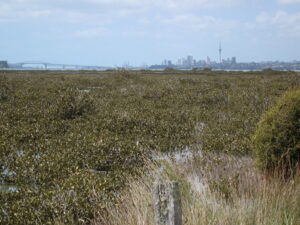
Mangrove conservation in Auckland
Auckland mangroves guided tours
Importance of mangroves for Auckland tourism
Mangrove restoration projects in Auckland
Auckland mangroves photography tips
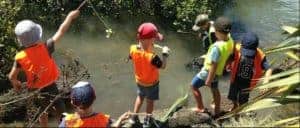
Auckland mangroves represent more than just a picturesque part of the coastal landscape; they are vital to the health of the region’s marine ecosystems. By understanding and appreciating the benefits about new zealands mangroves not nearly enough as its ecosystems, individuals can actively contribute to their preservation. Whether through supporting conservation initiatives, participating in guided tours to enhance awareness, or simply enjoying the recreational opportunities they offer, caring about Auckland’s mangroves is an investment in the sustainable future of this vibrant city.
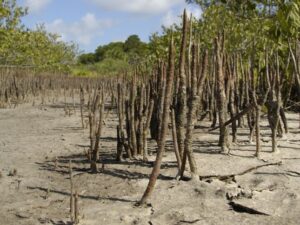
Auckland’s mangroves are not merely a feature of the city’s coastline; they are ecological powerhouses that contribute to biodiversity, erosion control, and water quality improvement. Recognizing the value of these coastal mangrove forest and scrub ecosystems invites a deeper connection with nature, offering opportunities for both education and immersive experiences. As Auckland continues to evolve, the preservation and understanding of its mangroves play a crucial role in maintaining the delicate balance between urban development and ecological sustainability.
Welcome to the enchanting world of Auckland sea kayaking – an unparalleled adventure that seamlessly blends human-powered movement, nature-based activities, and immersive social experiences. In this extensive guide, we will embark on a journey that not only educates but also compellingly convinces you to book a sea kayaking tour or course in Auckland. From the breathtaking benefits to the unique features, we’ll explore every aspect, ensuring you’re well-informed and eager to experience the wonders that Auckland’s pristine waters have to offer.
A. Physical Well-being:
Cardiovascular Fitness:
Engage in an invigorating full-body workout, paddling through the crystal-clear waters of Auckland for improved cardiovascular health.
Experience the joy of achieving fitness goals while surrounded by the scenic beauty of New Zealand’s coastlines.
Strength and Endurance:
Build strength and endurance as you navigate the gentle waves, enhancing your overall physical well-being.
Sea kayaking in Auckland becomes a dynamic exercise, toning muscles and promoting a healthy lifestyle.
B. Mental Serenity:
Stress Reduction:
Immerse yourself in the tranquil surroundings, leaving behind the stresses of daily life. Consider kayaking then glamping amongst vineyards
Discover the therapeutic benefits of sea kayaking, providing a mental escape and promoting a sense of calm; try our bioluminescence tour
Mindful Connection:
Experience the rhythmic paddling as a form of meditation, fostering mindfulness and a deeper connection with nature.
Auckland sea kayaking becomes a pathway to mental well-being, offering a break from the hustle and bustle. You can then relax at a nice brewery.
C. Nature Immersion:
Scenic Beauty:
Explore the breathtaking beauty of Auckland’s coastlines, with rugged cliffs, pristine beaches, and turquoise waters; see it all on the Browns island kayak tour.
Develop a profound connection to nature, appreciating the diverse marine life and stunning landscapes.
Wildlife Encounters:
Witness the wonders of New Zealand’s marine ecosystems, spotting dolphins, seals, and a variety of seabirds.
Auckland sea kayaking offers a front-row seat to nature’s spectacle, creating unforgettable wildlife encounters.
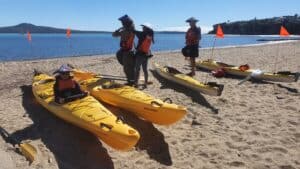
Auckland’s Coastal Wonders:
Navigate the iconic coastlines of Auckland, uncovering hidden gems and picturesque locations.
Discover detailed directions to key launch points, ensuring a seamless and enjoyable starting point for your sea kayaking adventure.
Island Exploration:
Embark on island-hopping adventures, discovering the unique charm of Auckland’s surrounding islands.
Get insights into the best routes and navigational tips for exploring the diverse landscapes.
Eco-Friendly Adventure:
Revel in the eco-friendly astroventure kayak experience of human-powered movement, leaving a minimal environmental footprint.
Auckland sea kayaking becomes a responsible and sustainable way to explore the region’s natural wonders.
Freedom of Exploration:
Enjoy the freedom and flexibility of exploring at your own pace, choosing your path through Auckland’s waters. Try sea kayaking for the Duke of Edniburgh award
Discover the secluded lucas creek waterfall, sea caves, and hidden beaches inaccessible by other means.

Delve into essential safety tips and precautions to ensure a secure and enjoyable sea kayaking experience.
Explore insights into the learning curve for beginners, offering guidance on acquiring the skills necessary for a successful sea kayaking journey.
Understand the essential equipment required for a safe and enjoyable sea kayaking experience in Auckland.
Learn about the availability of lessons catering to various skill levels, ensuring a tailored learning experience for every enthusiast.
Yes, SNM can fix any composite or plastic kayaks and equipment! Click here
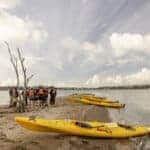
A. Community Engagement:
Connecting with Fellow Enthusiasts:
Join the thriving community of Auckland sea kayaking enthusiasts, fostering connections and shared experiences.
Discover forums, events, and social groups that enhance your sea kayaking journey through shared knowledge. Paddle to a pub! or Take to a Tavern!
Social Media Integration:
Stay updated on the latest sea kayaking trends, tips, and picturesque moments through active engagement on social media.
Connect with like-minded individuals and share your own experiences to contribute to the vibrant online sea kayaking community.
B. Nature-Based Activities:
Snorkeling and Marine Exploration:
Elevate your sea kayaking experience by incorporating snorkeling and underwater exploration activities.
Uncover the rich marine life beneath Auckland’s clear waters, adding a layer of excitement to your adventure.
Bird Watching Expeditions:
Combine the joy of sea kayaking with bird watching, discovering the diverse avian species along Auckland’s coastal regions.
Enhance your appreciation for nature as you observe the winged inhabitants of New Zealand.
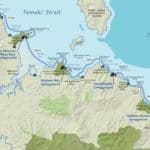
A. Investigating and Comparing Services:
Rental Options:
Explore reputable sea kayak rental services in Auckland, comparing equipment quality, pricing, and customer reviews.
Make informed decisions on the best rental options that align with your preferences.
Guided Tours and Courses:
Research guided sea kayaking tours and courses, evaluating itineraries, expertise, and customer testimonials.
Choose experiences that cater to your skill level and interests, ensuring a memorable and enjoyable sea kayaking adventure.
B. Booking and Reservation:
Online Booking Platforms:
Utilize user-friendly online booking platforms to secure your spot for a sea kayaking tour or course.
Take advantage of hassle-free reservation processes that streamline your journey from inquiry to adventure.
Exclusive Discounts and Packages:
Stay informed about exclusive discounts and special packages offered by sea kayaking providers in Auckland.
Maximize the value of your experience by exploring cost-effective options and promotional deals.
Auckland sea kayaking isn’t just an activity; it’s a transformative journey that offers a symphony of physical well-being, mental serenity, and a deep connection with nature. As you paddle through the azure waters, the rhythmic motion becomes a testament to the beauty that lies within Auckland’s coastal landscapes. Sea kayaking isn’t merely an adventure; it’s an opportunity to break away from the mundane, to reconnect with nature, and to discover the untamed wonders of New Zealand’s shores.
Why should you care? Because Auckland sea kayaking is a gateway to moments of awe, where the embrace of nature and the thrill of exploration converge. It’s a chance to forge connections with fellow enthusiasts, share stories, and become part of a community that